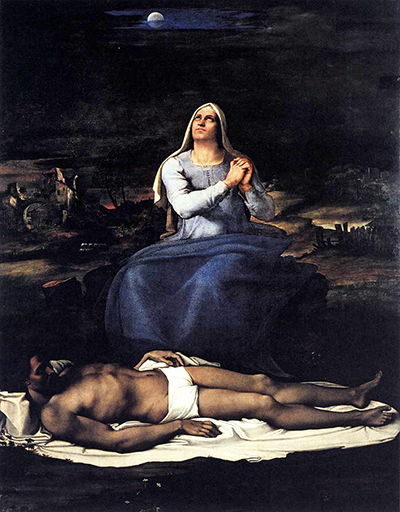Pietà was completed by Sebastiano del Piombo in around 1516-17 and is considered one of his finest paintings
The church of San Francesco di Viterbo was the intended destination for this breathtaking painting which underlines just what was possible when the creative minds of Sebastiano and Michelangelo joined forces in Rome. Giovanni Botonti was the donor for this piece and it is considered to be the artwork that helped to lift the artist's reputation to a new high.
This varied composition features both figurative work plus a sprawling landscape in the background. It is believed to be a view of the Italian region of Viterbo and the painting remains in this location today.
The nocturnal scene allows the figures to stand out even more significantly. This abruptness is not seen earlier in his career, prefering a style much more related to the Venetian School prior to his move to Rome. The background scenery is, however, still faithful to his eary teachings and so this artwork encompasses all that he had learnt across the papal states.
This painting was chosen as the feature work for a large exhbition at the National Gallery, London, UK in 2017. It is not only one of his most impressive works but it also displays the influence of Michelangelo on his style as well as any. The master taught him to better depict the human form and Pieta makes use of these improvements. There is also a grander look to each figure, again a sign of influence from the great man.
Michelangelo had taught and influenced Sebastiano through study sketches that he supplied to the artist on regular occasions. He believed that his pupil could become the finest artist in all of Rome, just so long as his skills as a draughtsman were improved.
The final painting measures 270cm x 225cm, making it one of Sebastiano's largest artworks. It now resides in the Museo Civico in Viterbo and is amongst the highlights of their entire collection. It is oil on panel, as with most of his career paintings and would likely to have included study sketches from his master at an earlier stage.
The Museo Civico is in the town of Barbarano Romano in the province of Viterbo and this work is its standout piece, thougth there is a fine selection of Italian art from a variety of periods to also appreciate here.
Whether you argue this composition to be a Pietà or a Lamentation, there can be no doubt that this Christian topic has been addressed by countless numbers of Renaissance artists. Sebastiano's contribution can certainly be considered one of the best within the medium of painting whilst his colleague Michelangelo produced the most famous Pieta sculpture.
There were also notable contributions along this theme from Pietro Perugino, Bronzino, El Greco, William-Adolphe Bouguereau,
Annibale Carracci, Eugene Delacroix and Titian, which were all paintings.




